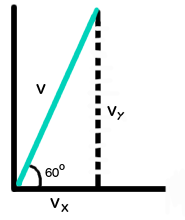A projectile is shot at an angle of #pi/3 # and a velocity of # 6 m/s#. How far away will the projectile land?
1 Answer
The projectile will land 3.2 meters away from its starting point.
Explanation:
I will give an in-depth explanation, as students tend to have some conceptual issues with these types of problems.
You are given the initial velocity and launch angle of a projectile. The angle indicates that you will need to break the velocity up into components,

We know that
Because we know that
where
Similarly, we can find
Now we have our horizontal and vertical velocities, and we want to solve for horizontal displacement. We can recognize fairly quickly that we don't have enough information about the horizontal motion in order to simply pick a single kinematic equation and plug in our known values, so another step must be required.
A lot of the time in these types of projectile motion problems, that other step involves calculating the time interval over which the projectile motion takes place, i.e. solving for
We know our acceleration and initial velocity vertically. This allows us to solve for time using either of two kinematic equations:
or
While both will yield the same answer, it is preferable to use the second option, which will not require use of the quadratic formula.
Thus, we can rearrange the second equation to solve for flight time using algebra. We will use that our final vertical velocity is equal to 0, calculating the projectile's rise time (the projectile momentarily stops when reaching its maximum altitude before falling back down).
Note: I have chosen not to include units in the above calculation as they make it difficult to read, but they are present. Also, note that I have defined the final y velocity as negative because the projectile will be falling toward the earth at the end of its motion, i.e. headed in the negative direction. This yields a favorable net-positive answer for time when we divide by
This gives us the rise time of the projectile, i.e. how long it takes to reach its maximum altitude. Assuming the projectile begins and ends at the same height, the rise and fall times are equal. Thus, the total flight time of the projectile is
Because time does not have x and y components, this time also applies in the x-direction. The only kinematic option to solve for horizontal displacement given our known values is:
We must recall that in projectile motion, there is no
If you choose to use the kinematic above, because
Thus,
Hope that helped!

